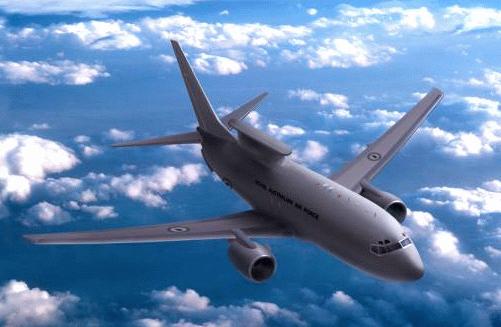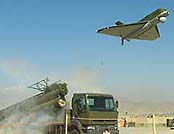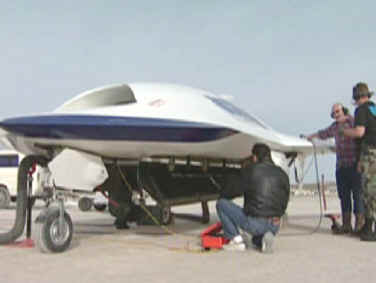Fighter pilots dread the day when the first fighter UAV takes flight, which can purse targets using internal radar just like today's AMRAAM air-to-air missiles, or may use an infrared search and track device, or both. Fighter UAVs can be guided toward enemy aircraft by a distant airborne or ground-based radar, or may cruise on automatic patrol. They can be half the size of a small fighter like the F-16 since they will not have a cockpit or ground attack systems. They will prove far too nimble for the world's best fighter aircraft to evade, especially because fighter UAVs can withstand far greater Gs; pilots blackout at 9 G turns.
A UAV fighter may be recoverable or expendable, probably both. If GPS navigation is available, it can automatically return and land at a specific spot when fuel is low. It may have landing gear or just deploy a parachute. Some may operate from a large mother aircraft that launches the UAV under-wing just like a missile, and then recovers it the same way. This may seem tricky, but recall that aerial refueling is equally tricky. If the mission is critical or very long-range, the UAV may be programmed to fly and fight until it runs out of fuel and crashes. Another option is to outfit them with an external drop tank to double their range.
A UAV fighter mothership may be like the two-seat F-15E, which may carry two UAV fighters underwing in addition to short-range missiles like the Sidewinder. The basic tactic is to launch a UAV fighter at enemy fighters at maximum range while the backseater controls the UAVs via a datalink. Perhaps two UAVs can be launched and controlled at the same time, but the problem arises of how to keep UAVs from attacking each other. Perhaps an Identify Friend or Foe (IFF) system is the answer, or they will just recognize each others smaller radar profile.
 Because targets will be much more valuable than
the UAVs themselves, they can be programmed to be extremely aggressive.
Not only will UAVs employ guns or missiles at aerial targets, they will
attempt to collide with them. This will be unnerving to enemy pilots, whose formations will quickly break up as they flee
from these crazed kamikazes. Meanwhile, F-15s in the distance watch the action
and may join in the kill while enemy fighters disperse.
Because targets will be much more valuable than
the UAVs themselves, they can be programmed to be extremely aggressive.
Not only will UAVs employ guns or missiles at aerial targets, they will
attempt to collide with them. This will be unnerving to enemy pilots, whose formations will quickly break up as they flee
from these crazed kamikazes. Meanwhile, F-15s in the distance watch the action
and may join in the kill while enemy fighters disperse.
The disadvantage of F-15 size aircraft is they haven't nearly the radar range of larger platforms like AWACS, which also has room for several UAVs controllers and numerous UAVs. One problem of using large aircraft as motherships is they are more vulnerable to enemy fire since they are slower and less maneuverable. Perhaps a large, fast aircraft like the B-1 bomber may be used, or just the practical Boeing 737, which costs less than an F-22. The US Navy has a new P-8 combat version of the 737 jumbo jet with underwing hardpoints for weaponry. An airborne radar version called the E-737 also exists. (pictured) Therefore, an EF-737 that can launch and recover four fighter UAVs underwing or underbelly is practical.
Ground-launched UAV fighters will be even more revolutionary. They do not need vulnerable fighter bases nor large ground-based radar support that can be jammed. Infrared search and track systems can provide target data to a truck-mounted UAV fighter if radar support is unavailable. Fighter UAVs may be launched to look for enemy aircraft and if nothing is found, they return home. After a parachute landing, they can be hoisted back on their launcher, refueled, and used again. The US Air Force deployed truck-mounted F-104 fighters during the 1960s that were boosted with small expendable rockets at launch, so the idea of a truck-mounted UAV fighter half their size is realistic.
 This will make the concept of total air superiority
against a modern army
part of history. Truck-mounted UAV fighters may appear from anywhere and just
one can devastate easy targets like helicopter transports and heavy
bombers. Recall that during the 1991 Gulf War, the US Air Force was unable to
locate and destroy a single SCUD missile launcher. They proved elusive even
after they were elevated to the priority target. In addition, their ballistic
launches were detectable by long-range radar, whereas UAV launches are not
ballistic.
This will make the concept of total air superiority
against a modern army
part of history. Truck-mounted UAV fighters may appear from anywhere and just
one can devastate easy targets like helicopter transports and heavy
bombers. Recall that during the 1991 Gulf War, the US Air Force was unable to
locate and destroy a single SCUD missile launcher. They proved elusive even
after they were elevated to the priority target. In addition, their ballistic
launches were detectable by long-range radar, whereas UAV launches are not
ballistic.
Therefore, a commander will employ nothing more than agile fighters and UAVs over enemy territory if hundreds of truck-mounted UAV fighters are hidden below. Today's surface-to-air missiles are normally detected from the flash of their rocket engines at launch. However, the launch of a truck-mounted jet-powered UAV fighter using pneumatic assist will be difficult to detect. In addition, escort fighters will find it difficult to chase down and destroy nimble UAVs. A UAV fighter will be more expensive than today's missiles. The US Air Force recently developed and successfully tested the stealthy X-45 (below) that can fly 0.9 Mach and carry a 3000 lb payload over 650 miles. This is a good start, but US Air Force fighter pilots seemed to have blocked development of a UAV fighter. The production cost of a X-45 is estimated at $15 million a copy.
 A UAV fighter will not tire during a
dogfight nor suffer vertigo or confusion. Without the weight and space required by a
cockpit its thrust to
weight ratio will exceed any manned fighter making it nearly impossible for
a fighter aircraft to pursue as it performs evasive maneuvers.
One problem is that a UAV cannot "see" behind itself. However, it
can be fitted with an aft mounted infrared search and track
device so that it automatically performs an evasive or counterattack maneuver
should anything approach from the rear, be it a fighter or missile.
A UAV fighter will not tire during a
dogfight nor suffer vertigo or confusion. Without the weight and space required by a
cockpit its thrust to
weight ratio will exceed any manned fighter making it nearly impossible for
a fighter aircraft to pursue as it performs evasive maneuvers.
One problem is that a UAV cannot "see" behind itself. However, it
can be fitted with an aft mounted infrared search and track
device so that it automatically performs an evasive or counterattack maneuver
should anything approach from the rear, be it a fighter or missile.
A UAV may be confused by countermeasures, but only for a few seconds after which it flies an automatic retargeting profile or re-engages with input from a distant controller watching on radar. It may be possible to jam external data from reaching the UAV, but this becomes difficult in an era of frequency-hopping communications. Nevertheless, each UAV will have its own internal flight plan to follow when its data link is lost. It may return toward base in hopes of reestablishing a data link, continue to pursue and attack if a target has been found, or fly a pre-programmed search and destroy pattern before returning to base.
Fighter UAVs will prove disastrous for modern air forces dominated by fighter pilots, which explains why the US Air Force refuses to evaluate this idea. While billions of dollars have been devoted to stealthy UAVs for reconnaissance, there is resistance from fighter pilots to even test UAV fighters. The development of fighter UAVs by other nations is just a matter of time. Less sophisticated nations once purchased top fighter aircraft but they learned they are no match for a sophisticated well-trained team of aircraft like those of the US Air Force. In addition, the cost and complexity of maintaining a professional cadre fighter pilots is unobtainable for most nations.
In contrast, fighter UAVs in storage require no spare parts, no fuel for training flights, and will not be lost during common training accidents. They can be stored in dehumidified bunkers for wartime use decades in the future. While they may become obsolete over time, they can always be used in a future warfare since sending them aloft puts no one at risk, except enemy fighters.
UAV fighters will act more like anti-aircraft missiles; launch them and let the computers do the thinking. Trained UAV ground controllers are needed, but their skills can be developed and maintained with simulators. In addition, they are not bothered by long flights, fear, or G forces as they have fun with their "video game." The controller skills are not critical as most UAV dogfights will occur with pre-programmed maneuvers. The UAV controller can just click the "PURSUE AND DESTROY" button and let the UAV do the thinking. If the UAV loses its data link, it follows a contingency command, which may be "SEARCH AND DESTROY" or "RETURN TO BASE."
The concept of launching squadrons of manned fighters for manly engagements against more maneuverable UAV fighters will become foolish. This does not mean the era of fighter pilots will end. UAVs are not as smart as pilots so they are dangerous for many missions in which friendly aircraft are nearby. Fighters are better for patrol, escort, and to pick up leakers that slip through air defenses. Human pilots will develop tactics for destroying fighter UAVs after substantial losses of their own. A typical engagement may see a dozen F-22s encounter a dozen UAV fighters. Since UAV fighters are much smaller without a radar-reflecting bubble canopy of a fighter, they will prove difficult to detect. After several minutes of dogfighting, several F-22s will be destroyed while the others flee with damage. All the $20 million UAVs may be destroyed, most likely because they were ordered to fight to the death.
While exhausted F-22 pilots fly home, the UAV controllers already ordered new UAVs uncrated and prepared for launch. By the time the controllers return from lunch, the new UAV fighters are ready for action, even before the F-22s land at their airbase. Meanwhile, the F-22 squadron commander ponders the risk of launching combat search and rescue missions into an area invested with UAV fighters, while the rescue of pilots or mourning their deaths are not even a factor for UAV fighter teams. Fighter UAVs are one of the true revolutionary changes in future warfare that no one is pursing.
©2015 www.G2mil.com